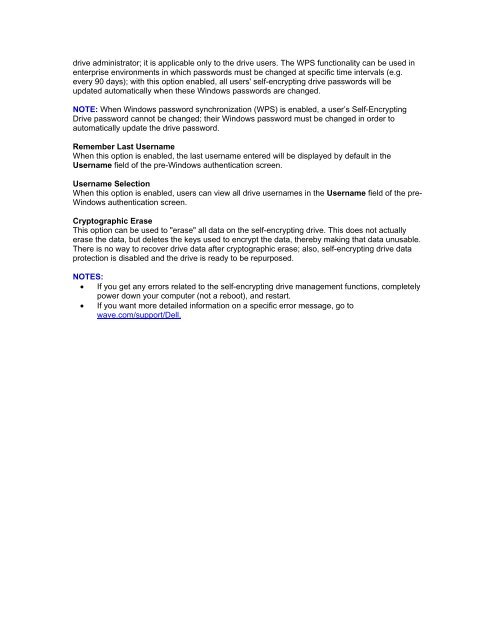DELL_SELF_ENCRYPTING_DRIVES
You also want an ePaper? Increase the reach of your titles
YUMPU automatically turns print PDFs into web optimized ePapers that Google loves.
drive administrator; it is applicable only to the drive users. The WPS functionality can be used in<br />
enterprise environments in which passwords must be changed at specific time intervals (e.g.<br />
every 90 days); with this option enabled, all users' self-encrypting drive passwords will be<br />
updated automatically when these Windows passwords are changed.<br />
NOTE: When Windows password synchronization (WPS) is enabled, a user’s Self-Encrypting<br />
Drive password cannot be changed; their Windows password must be changed in order to<br />
automatically update the drive password.<br />
Remember Last Username<br />
When this option is enabled, the last username entered will be displayed by default in the<br />
Username field of the pre-Windows authentication screen.<br />
Username Selection<br />
When this option is enabled, users can view all drive usernames in the Username field of the pre-<br />
Windows authentication screen.<br />
Cryptographic Erase<br />
This option can be used to "erase" all data on the self-encrypting drive. This does not actually<br />
erase the data, but deletes the keys used to encrypt the data, thereby making that data unusable.<br />
There is no way to recover drive data after cryptographic erase; also, self-encrypting drive data<br />
protection is disabled and the drive is ready to be repurposed.<br />
NOTES:<br />
• If you get any errors related to the self-encrypting drive management functions, completely<br />
power down your computer (not a reboot), and restart.<br />
• If you want more detailed information on a specific error message, go to<br />
wave.com/support/Dell.


